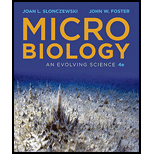
Concept explainers
To review:
The method to analyse the metagenome of a microbial community and the advantages and disadvantages of metagenomics as compared to culturing microbes.
Introduction:
To identify and study microorganisms, the microbes need to be cultured on nutrient media. Most of the microbes are difficult to culture and hence, cannot be characterized completely. Norman Pace was the first one to identify the microbe, by sequencing its Deoxyribonucleic acid (DNA). Metagenomics deals with the sequencing of the entire DNA extracted from the microbial community.
Explanation of Solution
The sequencing and analysis of the metagenome require a series of steps. The DNA samples are collected from the target community after separating the targeted microbes from their natural environment. The DNA is then isolated and purified from the microbes of interest. The small-subunit ribosomal RNA (SSU rRNA) amplification is done to study the species diversity.
The extracted and purified DNA can be cloned and sequenced. The assembling of sequenced DNA into genome can also reveal the diversity of species. One such technique is Illumina, which generates a large amount of data and require computational analysis. The sequenced DNA fragments are assembled using mathematical tools. The ecological functions of the microbes can be studied by functional annotations.
The limitations of the metagenomics are: it is difficult to assign the correct DNA sequence to the shared genomes. Different computational pipelines may predict different partial genomes. It is difficult to discover genomes of close relatives using pipelines based on reference genomes.
The metagenomics is an important toll that may reveal the characteristics and species diversity of an organism that cannot be cultured. It can also play a vital role in determining the species of microbes that are related closely. The evolutionary line of a microbe can also be revealed by the metagenomics.
Want to see more full solutions like this?
Chapter 21 Solutions
Microbiology: An Evolving Science (Fourth Edition)
- please fill in the empty sports, thank you!arrow_forwardIn one paragraph show how atoms and they're structure are related to the structure of dna and proteins. Talk about what atoms are. what they're made of, why chemical bonding is important to DNA?arrow_forwardWhat are the structure and properties of atoms and chemical bonds (especially how they relate to DNA and proteins).arrow_forward
- The Sentinel Cell: Nature’s Answer to Cancer?arrow_forwardMolecular Biology Question You are working to characterize a novel protein in mice. Analysis shows that high levels of the primary transcript that codes for this protein are found in tissue from the brain, muscle, liver, and pancreas. However, an antibody that recognizes the C-terminal portion of the protein indicates that the protein is present in brain, muscle, and liver, but not in the pancreas. What is the most likely explanation for this result?arrow_forwardMolecular Biology Explain/discuss how “slow stop” and “quick/fast stop” mutants wereused to identify different protein involved in DNA replication in E. coli.arrow_forward
- Molecular Biology Question A gene that codes for a protein was removed from a eukaryotic cell and inserted into a prokaryotic cell. Although the gene was successfully transcribed and translated, it produced a different protein than it produced in the eukaryotic cell. What is the most likely explanation?arrow_forwardMolecular Biology LIST three characteristics of origins of replicationarrow_forwardMolecular Biology Question Please help. Thank you For E coli DNA polymerase III, give the structure and function of the b-clamp sub-complex. Describe how the structure of this sub-complex is important for it’s function.arrow_forward
 Principles Of Radiographic Imaging: An Art And A ...Health & NutritionISBN:9781337711067Author:Richard R. Carlton, Arlene M. Adler, Vesna BalacPublisher:Cengage Learning
Principles Of Radiographic Imaging: An Art And A ...Health & NutritionISBN:9781337711067Author:Richard R. Carlton, Arlene M. Adler, Vesna BalacPublisher:Cengage Learning Human Heredity: Principles and Issues (MindTap Co...BiologyISBN:9781305251052Author:Michael CummingsPublisher:Cengage Learning
Human Heredity: Principles and Issues (MindTap Co...BiologyISBN:9781305251052Author:Michael CummingsPublisher:Cengage Learning





